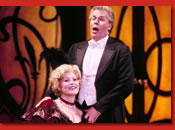
Performance by the Indianapolis Opera Ensemble and discussion by John Clark
When: Thursday 10 November, 7:00-8:30 PM
Where: Meridian Music Company, Recital Hall, 12725 Old Meridian St. Carmel, IN
Although I woul
 d hate to disagree with KP Singh, this could be the most enjoyable event of the Spirit & Place Festival. At any rate, it will be the most fun for me. Last year Sagamore Institute did a joint even with Indianapolis Opera, a mixed discussion and performance of the opera version of Arthur Miller's "Crucible." We policy wonks don't get to hang out in the world of high culture as often as we should, and the event was a real treat. This discussion and performance of "Merry Widow" should be even better. I've been fascinated with Lehár's Vienna since reading Robert Musil's Man without Qualities and Carl Schorske's Fin de Siècle Vienna. I feel fortunate to get to explore this fascinating world further.
d hate to disagree with KP Singh, this could be the most enjoyable event of the Spirit & Place Festival. At any rate, it will be the most fun for me. Last year Sagamore Institute did a joint even with Indianapolis Opera, a mixed discussion and performance of the opera version of Arthur Miller's "Crucible." We policy wonks don't get to hang out in the world of high culture as often as we should, and the event was a real treat. This discussion and performance of "Merry Widow" should be even better. I've been fascinated with Lehár's Vienna since reading Robert Musil's Man without Qualities and Carl Schorske's Fin de Siècle Vienna. I feel fortunate to get to explore this fascinating world further.How does a work of art, a unique product of a specific time and place, manage to transcend its roots, to move audiences across decades and cultures? Consider Franz Lehár’s timeless Merry Widow, perhaps the lightest of all light operas. Featuring a beautiful and wealthy young widow from the fictional Balkan statelet of Pontevedria who sets the fortune-hunters’ hearts aflutter, an ambassador’s wife whose flirtation with a handsome count threatens more than her marriage, gorgeous costumes and sumptuous sets, sensuous love songs and saucy cabaret number … The Merry Widow seems to possess no more substance than the bubbles in the champagne lubricating every scene. Perhaps it touches us today because it so perfectly captures the very essence of Vienna in 1905.

Yet even as Lehár was writing The Merry Widow, this enchanting Vienna was dying. Not long after the operetta's premiere the Archduke Ferdinand was assassinated in Sarajevo, in the real world neighborhood of Lehár’s Pontevedria, unleashing World War I and sending the Hapsburg Empire tumbling. (Only a few years ago we experienced the return of war to the real world Balkans.) Perhaps the Merry Widow’s audiences in Vienna knew they were waltzing at the edge of the abyss: just two blocks away from where Lehár composed such weightless and effervescent arias, Sigmund Freud was exploring the most dangerous corners of the human psyche. Perhaps something deeper and darker moves The Merry Widow beyond its Viennese roots. Perhaps we cherish the loveliness of the waltz today because we don’t want to think about our own abysses.
This event will explore the deeper side of Lehár’s Merry Widow, both in 1905 and 2005. Members of the Indianapolis Opera Ensemble will perform selections form the opera, while John Clark of the Sagamore Institute will discuss the work’s Hapsburg roots and the ways it moves us in a very different century and world. The Merry Widow will be performed on Friday, November 18, 2005 at 8pm and Sunday, November 20, 2005 at 2pm.
No comments:
Post a Comment